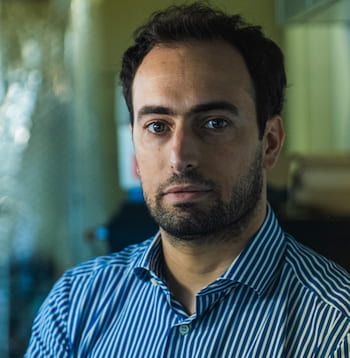Rice’s Pagano part of Science paper that ‘pushes’ exotic matter to characterize its dynamics
A recently arrived Rice University professor preparing to study quantum systems assembled from the ground up with individual atoms has two significant papers on which to build his reputation.
Guido Pagano, who joined Rice’s Physics and Astronomy Department right before the COVID-19 pandemic, is co-author of a new paper in Science that studies the dynamics of time crystals, materials that oscillate through changes over time when “pushed” by an outside source of energy, like an external drive. The goal is to see how they might be manipulated in ways that are useful for quantum sensing and computing.

Guido Pagano. Photo by Jeff Fitlow
A March paper in Nature Physics that demonstrated the capability of trapped-ion quantum simulators to investigate high-energy physics phenomena also came via the University of Maryland’s Joint Quantum Institute, where Pagano served as a research scientist before joining Rice.
The new paper’s main finding is that time crystals can be realized even in the absence of disorder.
Pagano said the first of these crystals he and his colleagues investigated for a 2017 Nature paper indicated that disorder ensured the crystal wouldn’t heat up over time. “That will happen if you have a subtle interplay of disorder and interactions that gives rise to a phenomenon called many-body localization, where the system fails to reach a thermal equilibrium,” he said.
“This time, we asked what happens if we don’t have disorder,” Pagano said. “Well, if you drive the system it will heat up eventually. However, if you drive hard enough, it takes an exponentially long time to do so.”
“This creates a different type of time crystal, which is called pre-thermal,” he said. “It basically means the system will equilibrate at some pre-thermal state. The thermal final state would be very boring and uniform with no features at all, but if you drive the system hard enough, you can actually see this time crystal over an extended period of time.
“The nice feature of the paper is that we can see there’s heating overall, and it’s behaving as expected, but changing the initial state of the system will result in a better or a worse time crystal, or no time crystal at all. We probe this by looking at different initial states of the system and then applying the drive.”
He said metrology — the study of measurement — could make effective use of time crystals’ extremely stable oscillations, but there is still a lot of work ahead to realize practical applications.
Pagano’s Rice lab will focus primarily on trapped-ion quantum simulators, as well as the advance of laser “tweezers” to manipulate single atoms and their interactions and explore new methods for quantum simulation and information processing. “These atomic systems are pretty flexible and controllable and can be even used to build universal quantum computers,” he said. “Once built, these machines will be able to run algorithms to solve a wide range of problems.
“Although at Rice we will be able to run algorithms at some point, in the near term we’ll focus more on the simulation of specific physics-related problems such as, for example, investigating high-energy physics models, studying how electrons transfer in molecules or solving hard optimization problems.”
Pagano is taking advantage of Rice’s deep knowledge of ultracold phenomena, particularly through research by Randall Hulet, the Fayez Sarofim Professor of Physics and Astronomy; Barry Dunning, the Sam and Helen Worden Professor of Physics and Astronomy, and especially Thomas Killian, the newly minted dean of the Wiess School of Natural Sciences.
“Tom has been a mentor since I came to Rice and he is now super busy with the Rice Quantum Initiative that was recently approved,” Pagano said. “It is really an exciting time to be a quantum scientist at Rice, and it’s also pretty unique to have a dean who totally understands what I do.”

